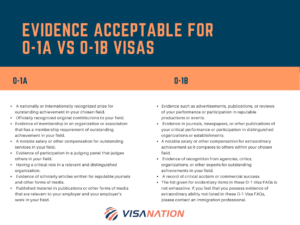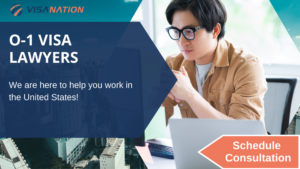Highly skilled professionals worldwide find working in the United States attractive. Those looking to succeed and stabilize in the U.S. have a range of visa options that may suit their particular situation. One unique pathway for skilled individuals to pursue is the O-1 visa. The O-1 visa comes with specific criteria and requirements to qualify. In this guide, we’ll take a deep dive into the O-1 visa qualifications, application instructions, expert tips, and more.
Getting An O-1 Visa
The O-1 nonimmigrant visa is for individuals with extraordinary skills in the sciences, education, athletics, arts, or in the motion picture/television industry and has international or national acclaim for those works. This nonimmigrant visa category breaks down into the following subsections:
- O-1A: Created for individuals with exceptional skills in sciences, education, business, or athletics (excluding the arts, motion pictures, or television industry). That doesn’t necessarily mean that you need a Ph.D. to secure this type of visa. The O-1 visa program is more flexible than many realize, allowing for various ways to establish your extraordinary qualifications. Learn more about O1 visa without PhD in this guide!
- O-1B: Designed for individuals with extraordinary talents in the arts or remarkable achievements in the motion picture or television industry.
Related to O-1 Visas
- O-2: Reserved for individuals who accompany and support O-1 artists or athletes during specific events or performances.
- O-3: Available to spouses or children of O-1 and O-2 visa holders.
A U.S. employer or agent must sponsor the O-1 visa. Check out this guide for more information on O-1 visa extension.
We make employment immigration to the U.S. easy.
O-1 Visa Requirements
One of the main O-1 requirements is demonstrating extraordinary ability “by sustained national or international acclaim.”

How does USCIS define “extraordinary ability”?
Extraordinary ability means a “level of expertise indicating that you are one of the small percentage who have risen to the very top of the field.”
For detailed information regarding how USCIS evaluates evidence to determine O-1A eligibility, including examples and considerations that are especially relevant for those in science, technology, engineering, and mathematics (STEM) fields, see the USCIS Policy Manual Volume 2, Part M, Chapter 4, Section C, and Appendix: Satisfying the O-1A Evidentiary Requirements.
Regarding the arts, this distinction means a “high level of achievement in the field of the arts.” Evidence can be provided by showing a degree of skill and recognition substantially above that ordinarily encountered.
For the motion picture/television industry, you must be “recognized as outstanding, notable or leading in the motion picture or television field.” An immigration attorney is best qualified to help you compile the necessary evidence to meet the stringent qualifications under the O-1 visa category.
Learn how to work for multiple employers on an O-1 visa!
Who qualifies for an O-2 visa?
To be eligible for an O-2 visa, your assistance must be an essential and indispensable part of the performance of the O-1A visa holder. You must possess specialized skills and experience with the O-1 visa holder that are not general and cannot be easily performed by a U.S. worker. If you are an O-2 visa holder in the motion picture or television industry, your skills and experience with the O-1 visa holder must be specific and crucial. This may be based on a pre-existing long-term working relationship or, in the case of a particular production, because significant production activities (including pre-and post-production work) will occur both within and outside the United States. Your continued involvement is essential for the successful completion of the production.

Learn all about the O-1 Visa for Start-up Founders.
Application Process – O-1 Visa
To begin the process of obtaining an O-1 Visa, you need to complete several steps. To avoid costly errors and delays, we strongly recommend hiring a qualified immigration attorney to submit your O-1 visa case.
Firstly, you should submit Form I-129, Petition for Nonimmigrant Worker, and the required filing fee.
Providing a written advisory opinion from a respected individual or peer group in your employer’s field is crucial. If you apply for an O-1 Visa in the motion pictures or television industry, the advisory opinion must come from a relevant labor union and management organization.
Additionally, you must include a copy of the contract between you and your employer. If there was an oral agreement, a written summary of the contract should suffice as long as it clearly states the terms offered by your employer and accepted by you. Furthermore, you must submit a detailed itinerary of the events and activities you plan to participate in in the United States. This itinerary must include the starting and ending dates.
Once you have gathered all the necessary information, VisaNation’s O-1 visa lawyers will handle the filing of the documents. The United States Citizenship and Immigration Services (USCIS) will review your petition. It’s important to note you should start the process should be at least 45 days but no more than one year before your employment date.
Recap of Important Documents
- Submit Form I-129, Petition for Nonimmigrant Worker
- Include written advisory opinion
- Include employment agreement
- Include a detailed itinerary of events/activities
Our Experience with One Client’s O-1A Visa
Our team has successfully helped many foreign professionals obtain an O-1A visa. This particular O-1 success story about a pilot from South Africa was riddled with challenges, including dealing with the uncertainty of a global pandemic. Still, in the end, we were able to come out on top and get his O-1A approved in February 2022! We proved that he satisfied at least four of the regulatory criteria, including having documented membership in relevant associations, employment in a critical/essential capacity, commanding a high salary, and serving as a judge or evaluator of the work of others. You can read the entire success story linked above!
We make employment immigration to the U.S. easy.
Frequently Asked Questions
Who can file an O-1 petition?
The O-1 petition needs to be filed by the sponsoring employer or an agent. Self-petitioning is not permitted. The petition must be submitted to the USCIS Service Center within your intended workplace’s jurisdiction. The nature of your O-1 job will determine whether you need an employer or an agent to sponsor your petition.
Who qualifies for an O-1 visa?
Individuals in the sciences, education, business, and athletics, with extraordinary talents in the arts, or remarkable achievements in the motion picture or television industry, qualify.
What is the salary requirement for an O-1 visa?
There isn’t a specific salary requirement per se that USCIS requires. However, the O-1 visa holder’s salary should reflect their extraordinary abilities or achievements. USCIS will evaluate various factors, including the applicant’s qualifications, reputation, and the nature of the employment, to determine if the offered salary is appropriate. Our team can help provide evidence and documentation for your case, demonstrating that the wage offered is reasonable and reflects your exceptional abilities.

Can I travel overseas on an O-1 visa status?
You can travel outside the United States while on an O-1 visa. Be sure to have these essential documents when wanting to reenter the United States:
- Passport (valid six months or longer than your O-1 visa expiration)
- Valid O-1 visas stamped in your passport (check your stamp expiration before traveling overseas)
- Form I-797 approval notice
Are O-1 visas hard to get?
Due to the stringent requirements, USCIS can require ample evidence for approval. For that reason, it’s imperative to have an immigration attorney handle your case.
How long does it take to get an O-1 visa?
You should initiate the O-1 visa process at least 45 days but no more than one year before your employment date. Typically we’ve seen that the O-1 processing time is faster than other visas like the H-1B visa. Consult your immigration attorney, but you should generally allot three to four months for the application to process. At the end of the day, the I-129 petition’s processing time depends on the service center responsible for processing it. As of June 2023, the processing time for the California Service Center for the I-129 is two months. The processing time for the Vermont Service Center is six weeks. Check up-to-date processing times here.
Is premium processing an option?
Yes! For a fee of $2,500, you can get premium processing for USCIS to process your petition in 15 calendar days or fewer.
How do I seek a change of status?
One benefit of the O-1 visa is that it is dual intent, so you can pursue your green card while you have that status. Learn more about Maintaining O-1 Visa Status and changing employers.
We make employment immigration to the U.S. easy.
What is the difference between the O-1 visa and the H-1B visa?
The H-1B visa is intended for employers who want to hire foreign workers in specialized occupations that require highly specialized knowledge and expertise. This visa typically necessitates a job offer from a U.S. employer and requires demonstrating that the position meets the criteria of a specialized occupation. Conversely, the O-1 visa is based on the individual’s extraordinary ability and focuses on the applicant’s qualifications. The H-1B visa is employer-focused and revolves around the job requirements and the sponsoring employer. Additionally, the O-1 visa does not have an annual cap, allowing for more flexibility, whereas the H-1B visa has a yearly numerical limit, resulting in a competitive selection process.
Alternatives to O-1 Green Card
Don’t meet the O-1 green card qualifications? Check out these alternatives:
- EB-1 Visa: This visa is for individuals with extraordinary ability in the sciences, arts, education, business, or athletics, outstanding professors or researchers, and multinational executives or managers.
- EB-2 Visa: This visa is for individuals with an advanced degree (beyond a U.S. bachelor’s degree) or significant competence in art, business, or science. Must pass the Labor Certification Process.
- EB-3 Visa: Designed for skilled, professional, or “unskilled” workers. The EB-3 Green Card has less strict requirements, but more eligible applicants exist compared to EB-1 and EB-2 categories.
- H-1B Visa: For skilled professionals with at least a bachelor’s degree in a field such as fields such as computer science, architecture, medicine, dentistry, engineering, accounting, etc. Benefits include dual intent, a three-year initial stay that can be extended, and the ability to bring dependents.
- L-1 Visa: This visa allows multinational companies to transfer executives, managers, and specialized knowledge employees to their U.S. offices. This visa has two subcategories- the L-1A for managers and executives and the L-1B for employees with specialized knowledge.
- T.N. Visa: Designed for Canadian and Mexican citizens seeking temporary employment in the U.S. under the North American Free Trade Agreement (NAFTA).
 Shilpa Malik
Shilpa Malik  Sabrina Saada
Sabrina Saada 
